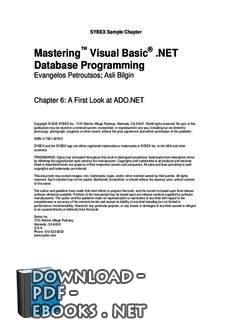📘 قراءة كتاب Mastering™ Visual Basic® .NET Database Programming أونلاين


ب 6
A First Look at ADO.NET
How does ADO.NET work?
Database Programming
The Connection object
The Command object
The DataAdapter object
The DataReader object
The DataSet object
Navigating through DataSets
Updating Your Database by using DataSets
Managing concurrency
What are .NET data providers?
What are the ADO.NET classes?
What are the appropriate conditions for using a DataReader versus a DataSet?
How does OLE DB fit into the picture?
What are the advantages of using ADO.NET over classic ADO?
How do you retrieve and update databases from ADO.NET?
How does XML integration go beyond the simple representation of data as XML?
Let’s begin by looking “under the hood” and examining the components of the ADO.NET stack.
حجم الكتاب عند التحميل : 717.1 كيلوبايت .
نوع الكتاب : pdf.
عداد القراءة:
اذا اعجبك الكتاب فضلاً اضغط على أعجبني و يمكنك تحميله من هنا:

شكرًا لمساهمتكم
شكراً لمساهمتكم معنا في الإرتقاء بمستوى المكتبة ، يمكنكم االتبليغ عن اخطاء او سوء اختيار للكتب وتصنيفها ومحتواها ، أو كتاب يُمنع نشره ، او محمي بحقوق طبع ونشر ، فضلاً قم بالتبليغ عن الكتاب المُخالف:
 قبل تحميل الكتاب ..
قبل تحميل الكتاب ..
يجب ان يتوفر لديكم برنامج تشغيل وقراءة ملفات pdf
يمكن تحميلة من هنا 'http://get.adobe.com/reader/'


 منصّة المكتبة
منصّة المكتبة